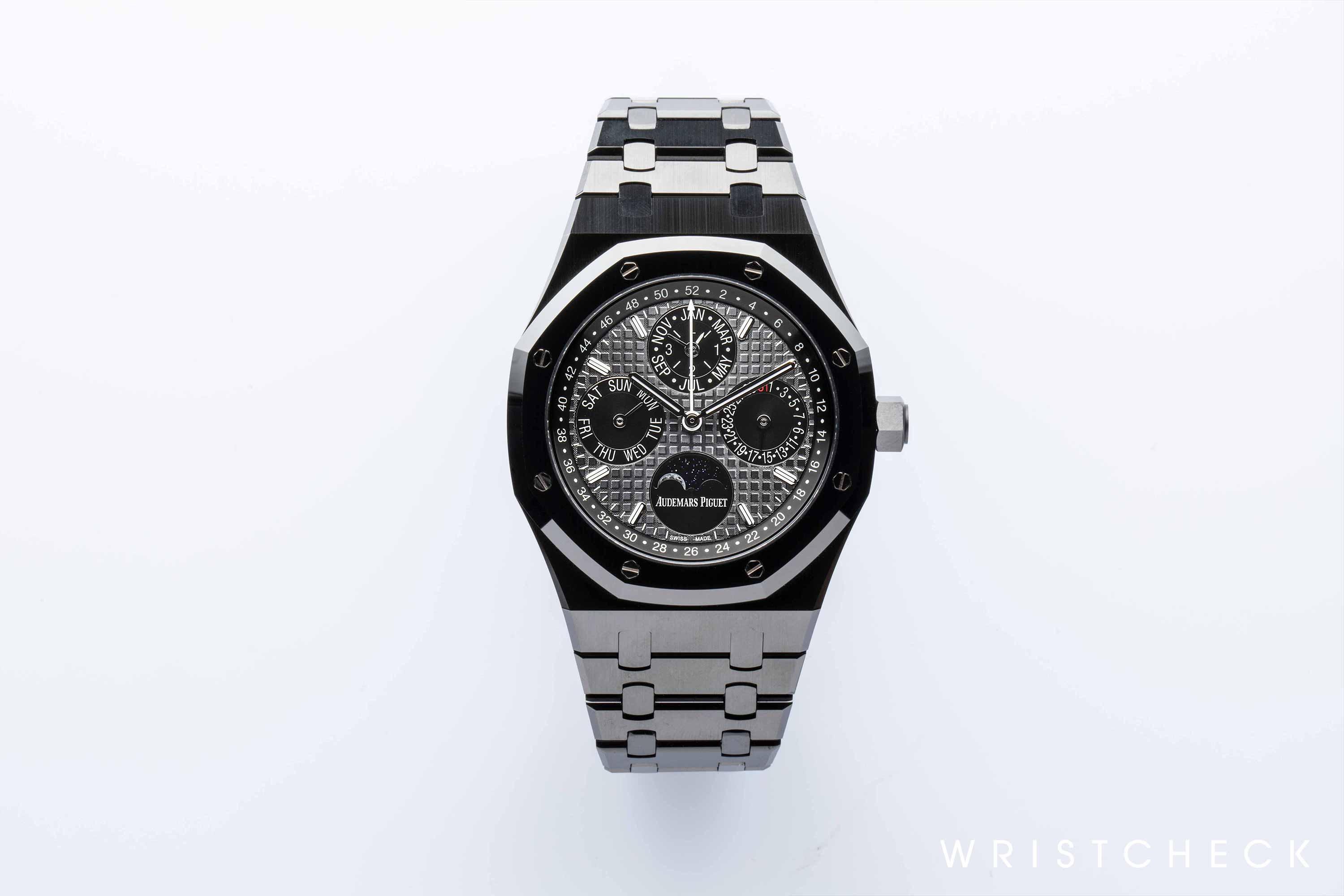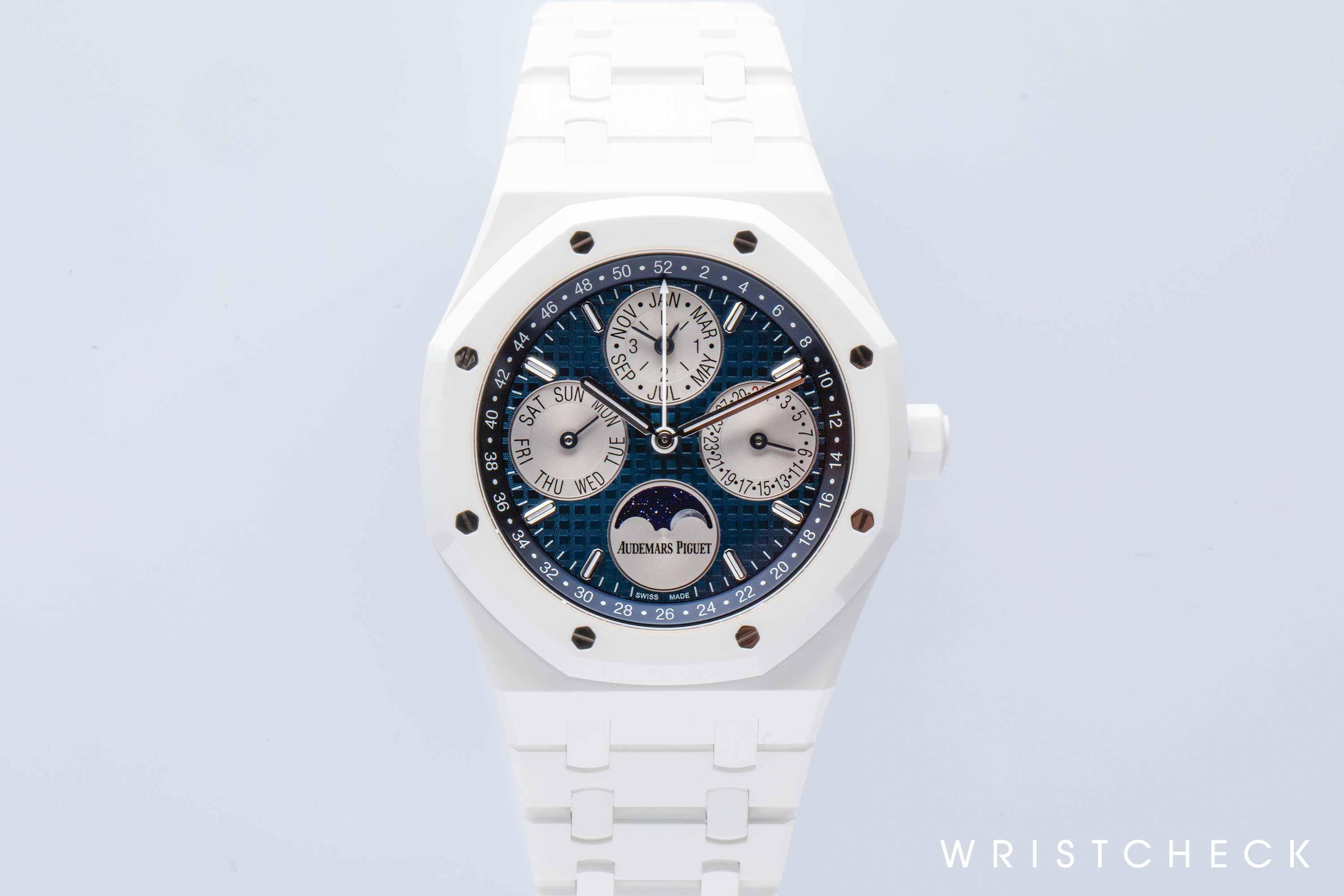
Royal Oak Perpetual Calendars In Black & White Ceramic
Today we look at two watches that are significant not only in their brand’s history, but also its future
When SIHH rolled around in 2017, little did Audemars Piguet know that one watch they brought along with them would make ceramic the hottest material in the watch industry. The watch in question, of course, was the Royal Oak Perpetual Calendar in full black ceramic.
This was the first time that the Maison had created a Royal Oak with both the case and the bracelet hand-finished in black ceramic. As you can imagine, the watch immediately stole the show, and thus became the central talking point of collectors at the fair.
With the popularity of third-party companies using coating techniques to turn watches fully black — even Royal Oaks — it was easy to speculate if Audemars Piguet had released the watch simply to grab a share of that growing market; to which Mr. François-Henry Bennahmias — AP’s ever-so-charismatic CEO — replied that they didn’t care about this, and simply wanted to challenge and push themselves to accomplish more in the realm of material use. Of course, some will recall that prior to the release of the full black ceramic Royal Oak, the brand had already made versions of the Royal Oak Offshore with ceramic bezels and cases, but never a full ceramic bracelet.

Apart from the iconic case design of the Royal Oak and its famous ‘tapisserie’ dial pattern, what every owner enjoys most about their RO timepieces is the bracelet, and its play on light. Looking across the industry, you'll find that there is simply no other timepiece that can generate the same effect. It's a perfect display of AP's mastery — acquired across decades — in manipulating materials like stainless steel, making them shine like precious metals.
Thus, obviously, this was a non-negotiable aspect of creating this watch; and given the complexity of the Royal Oak bracelet, achieving the same level of shine and play on light with black ceramic as they did with steel is simply remarkable. Even with the fickleness of black ceramic, AP managed to obtain their signature calibre of finishing, with brushed surfaces contrasted by highly polished edges.
Mastery of perpetual calendars
Choosing the perpetual calendar complication for the first full black ceramic Royal Oak made perfect sense. The Maison is known to have produced the first series of perpetual calendar wristwatches featuring a leap year indicator in 1955. Since then, the brand has had an uninterrupted history of creating exceptional calendar watches with milestones such as the release of the Audemars Piguet Perpetual Calendar Ref. 5548, the world’s thinnest self-winding perpetual calendar wristwatch at the time, in the late 1970’s amid the Quartz Crisis. In fact, this watch is said to have 'saved' Audemars Piguet, by playing to their strengths: traditional watchmaking, technical know-how and craftmanship. In the years that followed, many variations of their perpetual calendar watches were released, and in a variety of case designs and silhouettes, ranging from the Jules Audemars to the iconic Royal Oak.

This brings us to the 2017 Royal Oak Perpetual Calendar in black ceramic. Using the perpetual calendar complication within the full black ceramic case allowed Audemars Piguet to achieve a perfect blend of tradition and modernity; a way to take one of the most highly regarded complications, and merge it with a high-tech material.
The Royal Oak Perpetual Calendar Black Ceramic
The complexity of this ultramodern and cutting-edge Royal Oak lies within the amount of time required to finish the black ceramic material to AP’s standards. For reference: it takes six hours to machine, polish, hand-finish, assemble and control a stainless-steel Royal Oak bracelet — in comparison, it takes 30 hours to complete these exact same procedures for a black ceramic bracelet.
New moulds and tools had to be made to be able to craft and finish each link. Finding the right shade of black also proved to be a difficult task, as the formula truly had to be perfect in order to allow the ceramic to emit the right level of shine.


This sleek-looking, high-tech, all-black Royal Oak with a “slate grey” dial gave a new look and feel to the Royal Oak model, with the added bonus of being virtually unscratchable. Another advantage of ceramic, for collectors worried about their watches ageing over time, is that this will not happen with this material. Pick up your black ceramic watch again in 20-30 years, and it'll look just as good as it did the day you bought it.
“It Don’t Matter If You’re Black Or White”
Two short years after introducing the Royal Oak Perpetual Calendar in full black ceramic, AP pulled another one out of its pocket — this time in full white ceramic.

Immediately, one can tell that the two ceramic perpetual calendar watches are unique in their own ways. They both retain an extreme lightness paired with high durability — but the finishing on their ceramic is what sets them apart.
Now, don’t get me wrong: the finishing is exquisite on both versions, but you’ll have to look more closely at the white ceramic version than the black in order to really appreciate it. This is simply due to the monotonous nature of white, which tends to hide more of the fine work that has been done by craftsmen at the Manufacture.


The white ceramic Royal Oak Perpetual Calendar generates a beautiful contrast between its shiny blue dial and its white sub-registers.
It's worth pointing out that since the black ceramic version of the Royal Oak Perpetual Calendar came out in 2017, four more models of the RO (with various complications) were added to the lineup, each featuring a full combination of case and bracelet in black ceramic; whereas the full white ceramic treatment has only been given to one model. Is this due to the difficult production method, or the overall look and feel of the watch? Our best guess is a mix of both — but one thing we are certain of is that demand for AP’s ceramic pieces will not diminish anytime soon.
